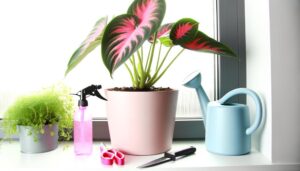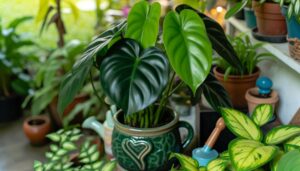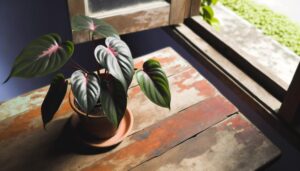Silver Sword Philodendron Care
To guarantee healthy growth of your Silver Sword Philodendron, create the necessary environment by focusing on providing bright, indirect light and maintaining a temperature between 60-75°F. The soil should be well-draining, preferentially with a slightly acidic to neutral pH.
Regular watering, allowing soil to dry between applications, is essential to preventing root rot. Additionally, a water-soluble fertilizer with NPK 20-20-20 can be added.
For ongoing care, prune brown or yellow leaves periodically and keep an eye out for pests like mealybugs and aphids. Exploring these tips further could reveal deeper layers of successful plant care.
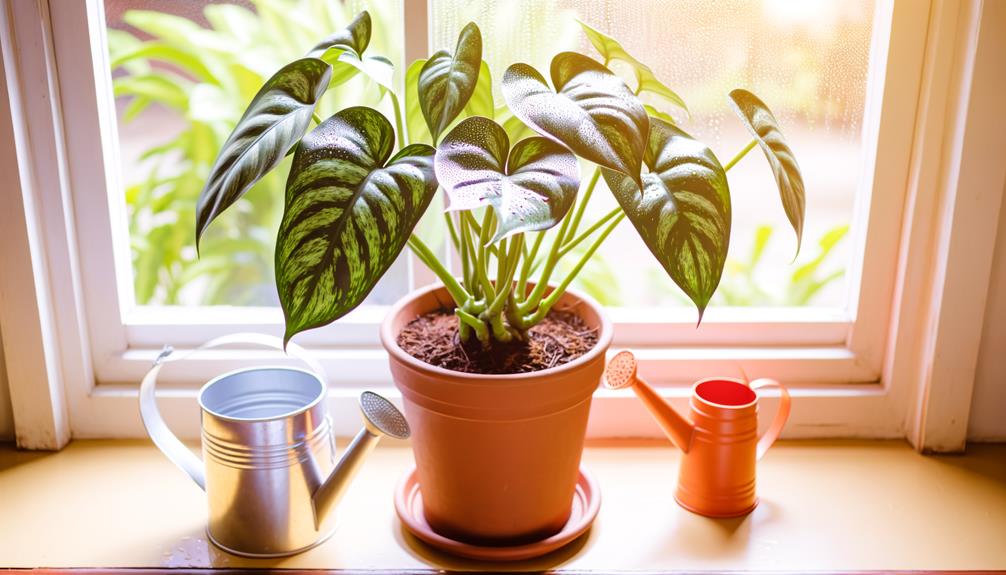
Key Takeaways
- Silver Sword Philodendron thrives in bright, indirect light with a temperature range of 60-75°F and 40-70% humidity.
- Water the plant consistently, allowing the soil to dry between sessions to prevent root rot.
- Use a well-draining, slightly acidic to neutral pH soil mix for optimal plant health and growth.
- Fertilize with a water-soluble NPK 20-20-20 fertilizer, maintaining a pH of 5.5-6.5.
- Periodically prune brown or yellow leaves and repot in larger containers in spring or early summer.
Understanding the Silver Sword Philodendron
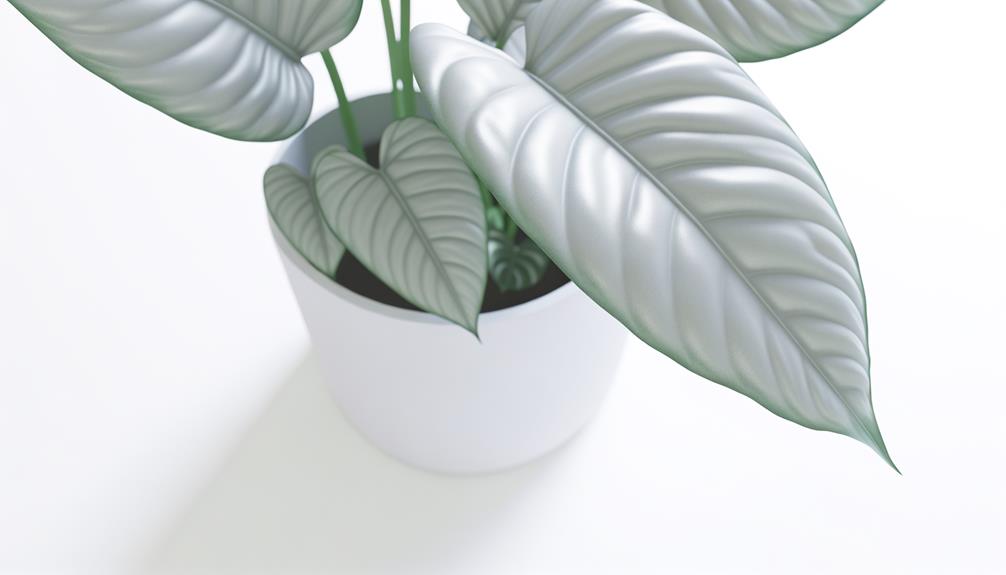
While the Silver Sword Philodendron, scientifically known as Philodendron hastatum, may initially appear intimidating due to its strikingly silver, elongated leaves, understanding its botanical properties and origin will greatly assist in its successful cultivation and care.
This tropical plant, native to Brazil's rainforests, has been admired for its unique sword-shaped leaves, which inspired its name. Belonging to the Araceae family, it is a robust climber with aerial roots, adapting well to indoor conditions. It prefers a loose, well-draining soil mix rich in organic matter.
The plant maintains its silvery hue throughout its growth and exhibits a moderate growth rate. Being a tropical species, it thrives in high humidity environments. Its best temperature range lies between 60-75°F (15-24°C). Understanding these characteristics is key to providing effective care.
Optimal Lighting Conditions
The Silver Sword Philodendron thrives under specific light conditions. Understanding these is important for its successful cultivation.
This discussion will focus on defining the plant's light requirements and providing guidance on how to avoid damage caused by inappropriate lighting.
It is through this understanding that one can create an ideal environment for the growth and sustainability of this unique plant species.
Understanding Light Requirements
One must note that the Silver Sword Philodendron thrives in bright, indirect light, being particularly sensitive to both extreme low and high light conditions. This tropical plant species, native to the understory of rainforests, is adapted to receiving filtered light rather than direct sunlight. Its photosynthetic mechanisms are optimised for diffused light, high humidity, and warm temperatures.
Excessive light can disrupt these mechanisms, leading to photoinhibition or even photodamage. Conversely, insufficient light can hinder photosynthesis, resulting in stunted growth and pale leaves. Ensuring the correct balance of light intensity, duration, and quality is critical for maintaining the health and aesthetic appeal of the Silver Sword Philodendron.
Ideal indoor locations include north-facing windows or spaces with light curtains that can filter harsh sunlight.
Avoiding Light Damage
To prevent light damage and achieve best lighting conditions, it's crucial to mimic the Silver Sword Philodendron's natural habitat as closely as possible. This involves creating a balance of diffused, indirect light that can support its photosynthetic processes without causing undue stress or damage.
This plant, native to the rainforests, thrives under the forest canopy where sunlight is filtered through the foliage above. Excessive direct sunlight can lead to chlorosis, a condition that causes yellowing of the leaves due to the degradation of chlorophyll. On the contrary, inadequate light can stunt growth and lead to leggy plants.
Hence, place your Silver Sword in a well-lit room, away from direct sunlight, but not in complete shade. Proper positioning is crucial for maintaining healthy, vibrant foliage.
Ideal Temperature and Humidity
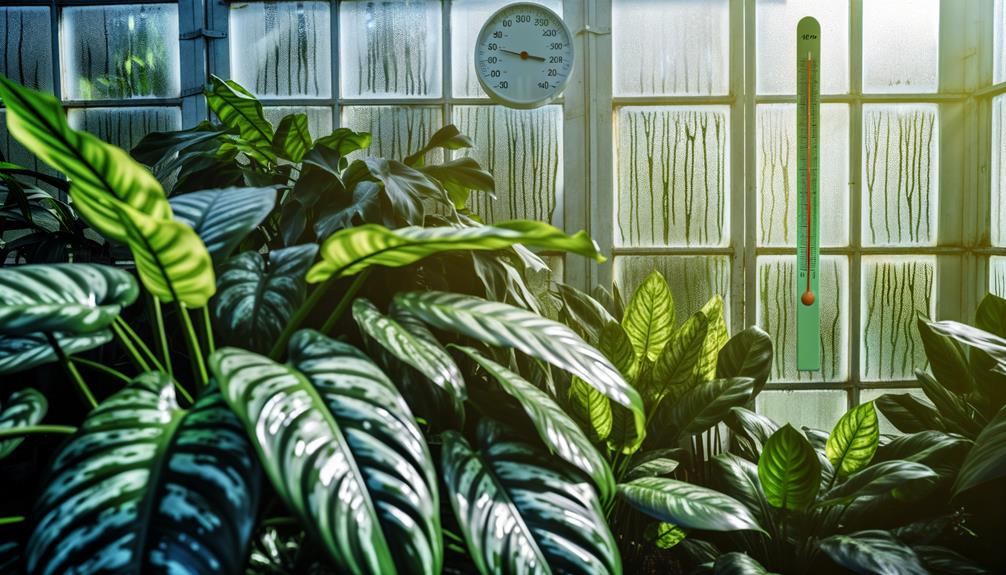
While flourishing in a variety of conditions, the Silver Sword Philodendron thrives best in a temperature range between 16°C (60°F) and 24°C (75°F), and humidity levels of around 40% to 70%.
Temperature:
The plant flourishes best in moderate temperatures, avoiding the extremes of excessive heat or cold. Sudden temperature changes can stress the plant, potentially leading to leaf drop or slow growth.
Humidity:
This tropical plant appreciates high humidity. However, it can adapt to lower levels provided it's not subjected to dry, arid environments for extended periods.
Room Selection:
Choose a room that offers stable temperature and humidity for peak growth. Avoid placing near heating or cooling vents which can cause drastic fluctuations.
Monitoring:
Regular monitoring of temperature and humidity can optimize the plant's growth, promoting healthy development and reducing the risk of disease.
Watering Your Silver Sword Philodendron
Proper hydration is vital for the Silver Sword Philodendron, as it depends on consistent watering patterns to maintain its vibrant foliage and overall health. This tropical plant prefers a thorough watering routine, where the soil is allowed to dry out slightly between watering sessions. This prevents oversaturation and mitigates the risk of root rot, a common problem in overwatered plants.
Ideally, the watering frequency should be once a week during the growing season, then reduced to bi-weekly during the dormant winter months. Use tepid water to replicate the plant's native rainforest conditions and make sure it is evenly distributed throughout the potting soil. Observing your plant's leaves for signs of under or overwatering, such as yellowing or drooping, can guide your watering practices.
Importance of Proper Soil Mix
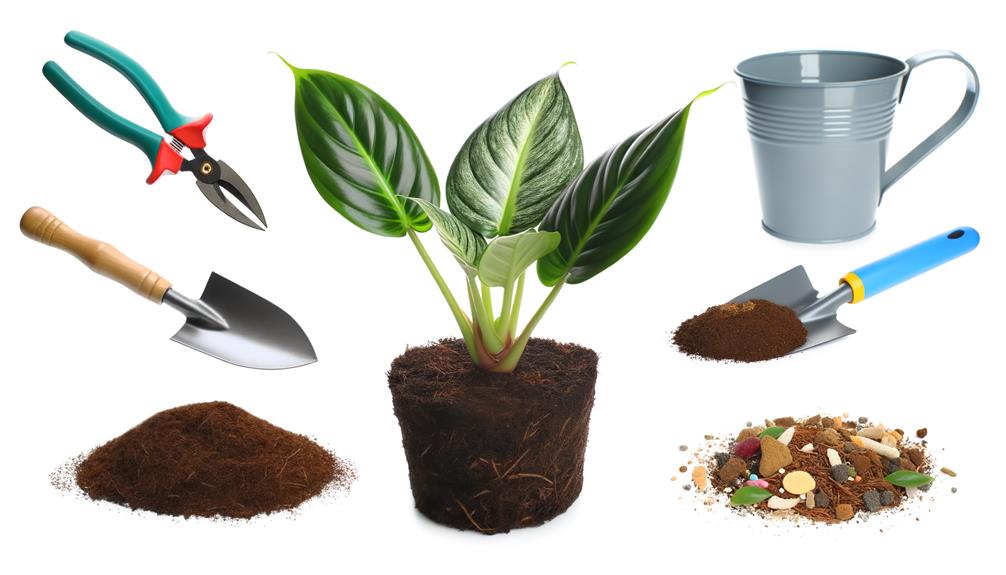
The health and vigor of the Silver Sword Philodendron are greatly influenced by the quality and composition of the soil in which it grows.
A careful selection of the right soil and appropriate mix ingredients is crucial to guarantee optimal drainage and aeration.
In the following discussion, we shall explore these aspects in detail, shedding light on their impact on the plant's growth and survival.
Choosing the Right Soil
Selecting the best soil mix significantly contributes to the healthy growth and flourishing of the Silver Sword Philodendron, a fact often undervalued by many indoor plant enthusiasts.
When choosing the right soil, consider:
- Drainage: Soil should be well-draining to prevent water-logging, which can lead to root rot.
- Acidity: Philodendrons prefer slightly acidic to neutral pH levels (5.6-7.5).
- Nutrient Composition: The soil should contain the essential nutrients needed for the plant's growth.
- Consistency: A lightweight, porous soil assists in maintaining the plant's health by providing necessary aeration to the roots.
These factors, while seemingly minor, have a significant impact on your plant's health. Selecting the right soil is a vital step in Silver Sword Philodendron care.
Soil Mix Ingredients
In the domain of philodendron care, understanding the importance and composition of an appropriate soil mix is essential to promoting strong growth and health in your Silver Sword Philodendron.
A well-balanced soil mix typically includes three main components: organic matter, minerals, and a pH adjuster. Organic matter, often compost or peat moss, provides necessary nutrients and enhances soil structure.
Minerals, which can include coarse sand or perlite, contribute to the overall soil stability and nutrient content. The pH adjuster, such as lime, is important in maintaining a slightly acidic to neutral pH level, allowing optimal nutrient absorption.
Such a soil mix ensures a healthy, thriving environment for your Philodendron, supporting its growth and aesthetic appeal.
Drainage and Aeration
Understanding the importance of proper soil mix for Silver Sword Philodendron is incomplete without considering the vital role of drainage and aeration. These two key factors directly influence the plant's overall health and growth.
- Drainage:
A well-draining soil mix prevents waterlogging and root rot. It ensures excess water escapes, providing ideal moisture levels.
- Aeration:
Soil aeration allows roots to breathe, promoting healthy growth. It prevents soil compaction, enhancing nutrient uptake.
- Soil Mix:
Incorporating elements like perlite, bark, and peat moss improves both drainage and aeration.
- Maintenance:
Regularly checking soil condition and making necessary adjustments help maintain ideal drainage and aeration.
Fertilization Techniques
To guarantee ideal growth and health of your Silver Sword Philodendron, it is crucial to adopt proper fertilization techniques. This should ideally include a balanced, water-soluble fertilizer rich in macro and micronutrients.
This particular plant species thrives best with a fertilizer having an NPK ratio of 20-20-20, applied on a monthly basis. It is vital to ensure the correct dosage, as excessive amounts can lead to foliage burn, while insufficient nutrients may result in stunted growth and chlorosis.
It is also worth noting that the plant's absorption capacity for nutrients is highest when the soil pH is slightly acidic, between 5.5 and 6.5. The incorporation of organic matter, like compost or well-rotted manure, into the soil can further enhance its fertility, promoting the overall vigor of the Silver Sword Philodendron.
Pruning and Repotting Tips
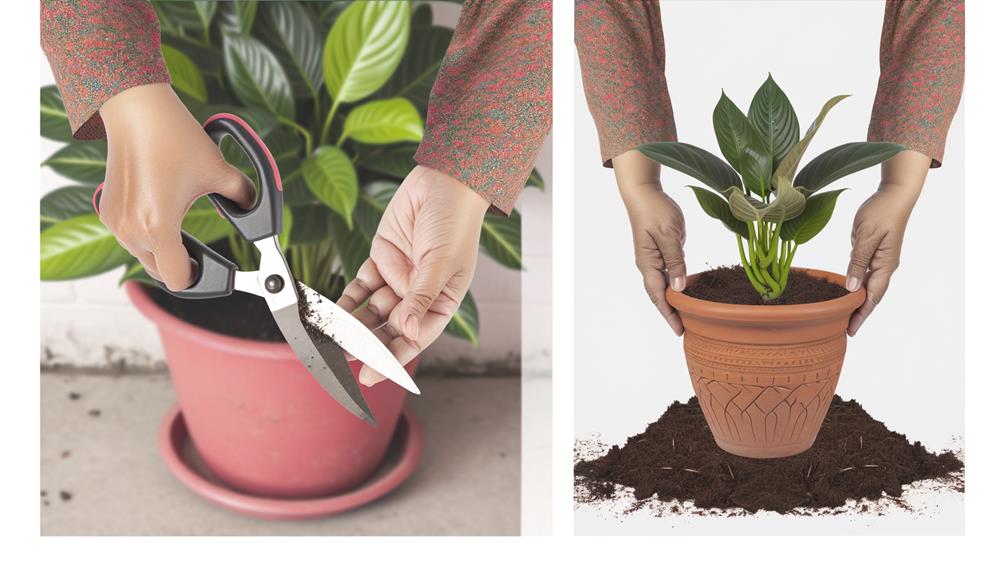
Regular pruning and strategic repotting are essential elements of Silver Sword Philodendron's care routine, aimed at maintaining its visual appeal and promoting strong, controlled growth.
To assist in your plant's care, consider the following steps:
- Prune your Silver Sword Philodendron periodically, focusing on removing brown or yellow leaves. This not only enhances the plant's appearance but also stimulates new growth.
- Make sure you're using sterilized cutting tools to prevent the spread of diseases.
- When repotting, select a container that's one size larger than the current one. This allows sufficient space for root expansion.
- The optimal time for repotting is during the growing season, usually in spring or early summer.
With these tips, you can guarantee your Silver Sword Philodendron thrives and brings joy to those who encounter its beauty.
Dealing With Potential Pests
Addressing pest issues promptly and effectively is a crucial aspect of Silver Sword Philodendron care, as these plants can occasionally be vulnerable to common houseplant pests like mealybugs, aphids, and spider mites. Early detection is crucial to prevent infestations. Signs of pest presence include curling, yellowing, or spotting on leaves.
To combat these pests, one can utilize biological methods such as introducing beneficial insects like ladybugs that prey on harmful pests. In severe cases, chemical treatment may be necessary. Use specially-formulated houseplant insecticides, but always follow the label instructions to avoid plant damage.
Regular monitoring and immediate action will guarantee the health and longevity of your Silver Sword Philodendron.
Conclusion
To sum up, the Silver Sword Philodendron, a seemingly unassuming houseplant, requires a specific routine of care. Its survival depends on the delicate equilibrium of light, temperature, and moisture.
This contradictory plant, flourishing in the organized disorder of nature, yet needing precise conditions in domestic environments, showcases the irony of plant care. By comprehending and following its care needs, one can foster the growth of this stunning, metallic foliage within the boundaries of the home.


